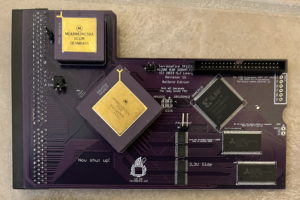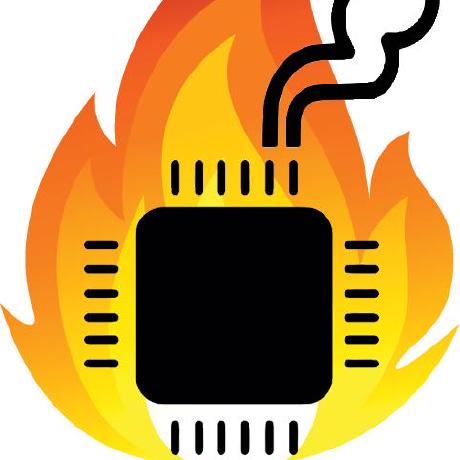You can buy the TF1232 on Amibay.

The TF1232 mounts 64 or 128MB SDRAM and a 68030 CPU running at 25 or 50MHz. It also features a PGA 68882 socket that can be populated with an FPU, also running at 25 or 50 MHz. The FPU can run asynchronously from the CPU, meaning you can use a 25MHz CPU and a 50MHz FPU and vice-versa.
The fast RAM will be added automatically on Kickstart 3.1 only. While the board will work under 3.0, you will have to add the memory manually.
USAGE UNDER KICKSTART 3.0 (39.106)
To use the board under Kickstart 3.0 you need to download the Addmem command from Aminet and add it to the beginning of your startup-sequence like this:
64MB version:
Addmem 08000000 to 0C000000
128MB version:
Addmem 08000000 to 0FFFFFFF
You also have the option of soft-kicking Kickstart 3.1 using SKick from Aminet. This procedure assumes that the Skick archive has been upacked to your boot drive, the Kickstarts directory from the archive copied into Devs:, and that you have a valid A1200 Kickstart 3.1 file placed in Devs:Kickstart.
To do so, you can create a simple script inside the startup-sequence that will check which ROM version you are running, add the fast memory load kickstart 3.1 and reboot.
Here’s an example of how to create such a script:
Version >NIL: graphics.library 40
IF WARN
Echo "3.0 ROM detected"
Addmem 08000000 to 0C000000
Skick devs:kickstarts/kick40068.A1200 32BIT
EndIF
DISK IMAGE
If all the above seems rather complicated, you can download my disk image that has everything already preset from here. You can write it onto an 8GB CF/SD card using Win32DiskImager. The disk image is based on my CD32 one. Please note that by default it boots into NTSC mode, so you need to make sure that your display hardware supports it (apparently not every version of the OSSC does support NTSC).
A1200 TIMING FIXES
If you experience random lockups and freezing and your A1200 has the E123C and E125C caps mounted on the bottom of the motherboard, you should remove them. Their presence is not necessary and can make the board unstable.
A1200 EDGE CONNECTOR
Please ensure your A1200 does not contain an unbevelled connector. A small minority of A1200s suffers from this problem. If you attempt to plug the TF1230 into one of these, it can damage the expansion connector. For more information please check this link.
TF IDE INTERFACE
The TF1232 IDE interface is operational, but the device does not support autobooting, since the driver is not part of the Kickstart ROM. However, you can load the driver manually from disk by using the loadmodule command (e.g. loadmodule devs:ehide.device).
You can also create a custom Kickstart with ehide.device included, which will then let you boot from it.
You should keep the IDE cable as short as possible to avoid encountering issues.
RTC
There is no RTC on the 1232, however the Amiga 1200 has a clockport on the motherboard that you can use to add an RTC. RTC Clockport modules are available from official Amiga resellers.
The onboard A1200 IDE and PCMCIA interfaces remain operational while using the 1230.
Ehide.device driver download:
You find the ehide.device inside this archive here: https://alen.dreamhosters.com/TFTools.zip, but please note that only the the ehide.device is applicable to the 1232. The other files are used by the TF1260 only.
Adding an FPU
You can add an FPU to the TF1232 directly. The FPU can be a 68881 or a 68882. The onboard jumpers allow you to configure the speed at which it runs.
If your A1200 has an FPU soldered on its motherboard, it will be automatically ignored. That means that even if you don’t have an FPU on the TF1232, the 68882 soldered on the A1200 motherboard won’t be used. It will also not create any conflicts in case both FPUs are installed, as only the one on board the TF1232 will be used.
Jumpers
ENABLE030: Enables/Disables the accelerator. PLEASE NOTE: This function does not work on the release firmware. A firmware update is required for cards shipped before 2024-02-22 to enable this function.
CPU25MHZ: Switches between 25/50 Mhz CPU operating mode. When the jumper is present, the CPU runs at 25MHz. When it is removed, it runs at 50MHz. Warning: if your CPU cannot run at 50MHz the system will not boot or will crash frequently. Note that not all 50MHz CPUs will operate correctly at 25MHz.
FPU25MHZ: Switches between 25/50 Mhz FPU operating mode. When the jumper is present, the FPU runs at 25MHz. When it is removed, it runs at 50MHz. Warning: if your FPU cannot run at 50MHz the system will not boot or will crash frequently.
Headers
FAN: allows you to connect a 12V CPU fan. Please note: this jumper is not soldered by default to avoid accidental shorts on the 12V line. There are rare cases in which a 68030 requires an active fan so it is unlikely that you will need it. If you do request this header to be added, please be careful not to place jumpers or short this pin. You will kill the board or your Amiga if you do.
HDDLED: allows you to connect an IDE activity LED for the TF IDE interface.
Known Issues
– Some Kingston branded CF cards do not work in conjunction with this accelerator. This is currently under investigation. You can bypass this issue by using other brands of CF cards (e.g. SanDisk).
– If you experience crashes while devices are connected to the EHIDE interface, you can solve them by adding an IDE buffer to the A1200 motherboard.
– The card will not boot if you have a long cable connected to the A1200 IDE. This too can be solved by adding an IDE buffer to the A1200 motherboard.
| Firmware | Date published | Applicable to boards (built by alenppc) with serial numbers | Comments |
| tf1232r1_2024_05_27_alpha | 2024-06-10 | 1-21 | Fixes an ehide lockup issue that occurs in specific conditions when FastRom function is not used |
